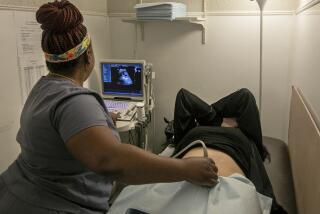Down Syndrome Seen Earlier With New Test
Down syndrome can be safely detected in the first trimester of pregnancy -- several weeks earlier than is now possible -- using a combination of blood tests and ultrasound, researchers report today in the New England Journal of Medicine.
A study involving more than 38,000 pregnant women showed that the combination test could detect 87% of Down cases as early as 11 weeks into the pregnancy. The blood test now used in the second trimester detects about 80% of cases.
For the record:
12:00 a.m. Nov. 11, 2005 For The Record
Los Angeles Times Friday November 11, 2005 Home Edition Main News Part A Page 2 National Desk 1 inches; 56 words Type of Material: Correction
Down syndrome -- An article in Thursday’s Section A about a new test for Down syndrome said two other tests -- chorionic villus sampling and amniocentesis -- involved removing cells from a fetus. Chorionic villus sampling uses cells from outside the amniotic sac covering the fetus. Amniocentesis uses cells from the amniotic fluid surrounding the fetus.
“These results will undoubtedly change national practice,” said Dr. Mary E. D’Alton of Columbia University College of Physicians and Surgeons, one of the study’s authors. “All pregnant women should have the option of early screening for Down syndrome in their first trimester.”
Early screening would give women carrying an affected embryo the option of having an abortion earlier in the pregnancy when the risks to the mother are lower, or allow them more time to prepare themselves should they carry the pregnancy to term.
“We believe every pregnant woman should have it,” said Dr. Michael Y. Divon, chairman of obstetrics and gynecology at Lenox Hill Hospital in New York.
Officials at the American College of Obstetricians and Gynecologists indicated Wednesday that they would probably update their guidelines on prenatal screening in light of the findings.
Experts cautioned that a limited number of imaging experts have been trained to perform the ultrasound test, which is trickier than a conventional ultrasound used, for example, to observe gross defects or to learn the fetus’ sex.
For physicians who cannot offer the test now, “it is prudent to let a patient pursue it elsewhere,” Dr. Joe Leigh Simpson of Baylor College of Medicine wrote in an editorial in the same issue of the journal.
Down syndrome, which occurs in one of every 660 to 800 pregnancies, is one of the leading causes of mental retardation.
Children born with the syndrome have distinctive facial features -- eyes that slant upwards; small ears, nose and mouth; and a flattened nasal bridge -- and other birth defects and medical problems.
The problem is most often associated with pregnancy in older women.
The syndrome is caused by the duplication of one member of chromosome pair 21, a condition called trisomy 21. It can be verified with 100% accuracy by two prenatal tests: chorionic villus sampling or amniocentesis. Both procedures require removing cells from the fetus for testing and entail a small risk of producing a spontaneous abortion. Screening tests are used to identify high-risk pregnancies, minimizing the number who undergo the more invasive tests.
Currently, women are offered a test, called the quadruple test, at about 16 weeks of gestation. That test looks for unusual levels of four different enzymes and hormones in the blood.
In the new test, researchers measure the levels of two hormones in the mother’s blood. They also use ultrasound to measure the thickness of the skin on the back of the fetus’ neck, which has been found to indicate a potential problem.
In the $15-million, 8-year study sponsored by the National Institute of Child Health and Human Development, researchers enrolled 38,167 pregnant women at 15 U.S. centers. The women received the new test and the conventional quadruple test.
If either test suggested a problem, they also were offered the invasive tests. The team identified 117 embryos with Down syndrome.
The group reported that using the new test in the first trimester detected 87% of Down cases.
The quadruple test in the second trimester detected 81%. Together, they identified 95%.
Each test had a false positive rate of about 5%.
D’Alton and other experts, working with the Society of Maternal-Fetal Medicine, have recently formed the Maternal Fetal Medicine Foundation to facilitate physician training and quality control for the procedure. So far, she said, about 1,600 physicians and sonogram technicians in the United States have been trained.






